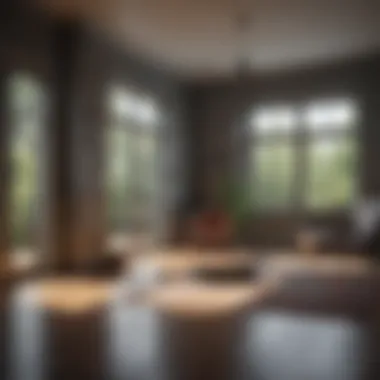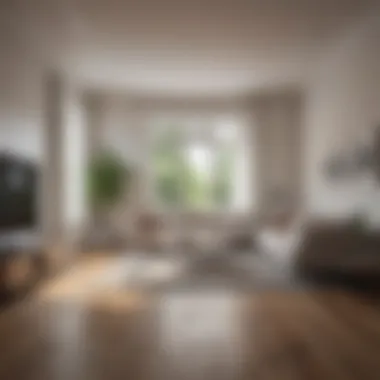Measuring Square Feet: Techniques for Accurate Results


Intro
Measuring square footage is a crucial skill that impacts various aspects of home ownership, whether its for renovation, design, or real estate valuation. Understanding how to accurately measure a room can save time and money. Moreover, it ensures that spaces are used effectively. This guide will present methodologies, tools, and best practices for measuring square feet.
Home Features
Architectural Elements
When measuring square footage, one must consider the unique features of a home. Architectural marvels, such as vaulted ceilings or angled walls, often complicate measurements. These structures can add character but may require specialized techniques to determine their square footage correctly. For instance, measuring an irregularly shaped room involves breaking the space into more manageable segments.
Accurate measurement lays the foundation for effective design and renovation.
Unique Features in Design
Certain rooms also have design elements that affect measurements. Built-in shelves, large windows, and even fireplaces can influence the usable square footage. It is necessary to acknowledge these aspects when planning any renovation or design work. For instance, measuring the area of built-in furniture can lead to more informed decisions regarding furniture arrangement and overall space utilization.
- Key considerations include:
- Measuring around obstacles like beams or columns.
- Acknowledging functional areas such as closets or alcoves.
Interior Design Inspirations
Color Considerations and Space
The size of a room often influences color choice in interior design. Lighter colors may make a small room feel larger, while darker tones can create a cocooning effect in spacious areas. Measuring square footage helps determine wall space, therefore helping in the calculation of materials needed for painting or wallpapering.
Placement of Furniture
Furniture arrangement encompasses both aesthetic and practical considerations. A well-measured room allows for a functional layout that facilitates movement and usability. For effective furniture arrangement, consider:
- The scale of furniture pieces in relation to the room.
- Flow of movement and accessibility.
- Creating focal points while maintaining balance.
Epilogue
Accurate measurement of square footage is more than a simple task; it impacts design decisions, renovations, and overall livability. By understanding the nuances behind measuring techniques and tools required, one can achieve a greater appreciation for space. Such knowledge empowers homeowners to make informed decisions that enhance their environments.
Foreword to Square Foot Measurements
Measuring square footage is an essential aspect of various domains, particularly in real estate and interior design. The concept of square foot measurements allows for a standardized way to express the size of a space, making it easier to compare different properties and understand their potential. Accurate measurements inform buyers and renters about the actual area they are considering.
Understanding how to measure square feet not only helps in assessing property value but also plays a crucial role in effective design and renovation. When you measure a space precisely, you can better plan for furniture, ensure compliance with building codes, and create functional layouts. This article aims to demystify the process of measuring square footage through clear explanations and practical examples.
In this section, we will explore the following key elements:
- Standard Practices: Familiarity with accepted methods makes measurements reliable.
- Impact on Decision Making: Knowing the right area influences choices in purchasing or renting a space.
- Common Applications: From renovations to real estate, measurements have broad implications.
The ability to measure square footage accurately can provide numerous benefits. For instance, it aids in maximizing the utility of a space, guiding interior design choices, and ensuring that renovations stay within budget.
Consider this:
"Accurate square footage measurement can greatly influence property listings, pricing, and design effectiveness. Thus, robust measurement knowledge is key."
In summary, the introductory section lays the groundwork for understanding square foot measurements. From grasping standard practices to the implications of accuracy in real estate and design, this knowledge is critical for anyone engaged in these fields.
Importance of Measuring Square Feet
Measuring square feet holds significant weight in various domains, primarily in real estate, interior design, and renovation projects. Understanding the precise square footage of a space can influence decisions that affect both financial outcomes and aesthetic appeal. When buying or selling property, accurate measurements serve as a foundation for establishing value. Listings that provide correct square footage can attract more inquiries and help set realistic price expectations.
In real estate, buyers often compare properties based on size. A home with more square footage may appear more valuable, leading to negotiations that hinge on these metrics. If measurements are incorrect, it can result in disputes and dissatisfaction, ultimately affecting both buyer and seller.
From a design perspective, knowing the square footage allows for effective space planning. Designers need precise dimensions to ensure functionality and to harmonize aesthetics within a room. This detail is also essential for building codes and regulations, which often stipulate minimum space requirements for safety and livability.
Consider the following benefits of accurately measuring square feet:
- Financial Implications: Accurate measurements can lead to better pricing in the market, potentially increasing property value.
- Optimal Space Usage: Understanding square footage allows for better design choices and efficient relocation of furniture and fixtures.
- Regulatory Compliance: Some projects require adherence to specific square footage guidelines, making precise measurement essential.
"Accuracy in square footage measurement can directly impact both financial choices and design functionality."


Homeowners planning renovations must also recognize the relevance of square footage. Knowing how much space is available informs choices regarding additions, layout changes, and even the types of materials to be used. For instance, adding a new room requires detailed calculations to ensure that the overall design remains practical and compliant with local building codes.
Thus, the importance of measuring square feet extends far beyond simple numbers. It influences economic viability, aesthetics, and compliance, making it indispensable in both professional and personal contexts.
Essential Tools for Measurement
Measuring square footage accurately requires specific tools that enhance precision and ease. Knowing which tools to use can significantly affect the quality of your measurements. This section will explore three essential tools: tape measures, laser measurement tools, and measurement apps. Each tool has its unique advantages, suitable for different scenarios and user preferences.
Tape Measure
The tape measure is a traditional but essential tool for measuring space. It is flexible, allowing users to gauge dimensions in various settings. Tape measures are typically made from steel or fiberglass, offering durability and ease of handling. A standard tape measure extends to 25-30 feet, making it suitable for most interior spaces.
Using a tape measure requires a steady hand and proper technique. Here are key considerations:
- Readability: Ensure you select a tape measure with clear markings. This helps avoid confusion when reading measurements.
- Hook Mechanism: The hook at the end of the tape should be used properly. It can slide, allowing for accurate measurements. If measuring from inside, pull the tape to accommodate this.
- Metric and Imperial Units: Many tape measures offer both metric and imperial measurements. Understanding both systems expands your versatility in measuring.
Overall, the tape measure is reliable for straightforward measurements, making it a staple in any toolbox.
Laser Measurement Tools
Laser measurement tools represent a significant advancement in measuring technology. These devices use laser beams to calculate distances, providing high accuracy with minimal effort. The accuracy and speed of laser tools can be highly beneficial, especially in large spaces or when measuring hard-to-reach areas.
Benefits of using laser measurement tools include:
- Precision: They often provide measurements within 1/16 of an inch, which is valuable for intricate projects.
- Efficiency: Measuring with a laser tool can be significantly faster than traditional methods. Users can simply point and measure.
- Versatility: Many models include additional features like area calculation and volume measurements.
However, it is essential to understand the limitations as well. Laser tools depend on line of sight and may not measure accurately through obstacles. Proper calibration is also necessary to ensure measurement accuracy.
Measurement Apps
In today’s digital world, measurement apps have emerged as practical tools for measuring square footage. These applications, available on smartphones and tablets, typically use the device’s camera or sensors to provide measurements.
Key features of measurement apps include:
- User-Friendly Interface: Most apps are designed to be intuitive, making them accessible for users with different skill levels.
- Integration Options: Many apps allow users to save calculations, share them, or integrate with other design software.
- Convenience: They can be used on the spot, reducing the need for physical measuring tools in some cases.
However, accuracy may vary based on the device’s capabilities and the user’s proficiency. It is advisable to cross-check measurements obtained from apps with traditional tools for critical tasks.
In summary, having the right tools is crucial for effective square footage measurement. Each tool offers unique benefits, enhancing accuracy and efficiency in different scenarios.
Understanding these tools will empower readers to choose the most suitable option for their needs, be it a simple room measurement or a multifaceted design project.
Basic Measurement Techniques
Understanding basic measurement techniques is crucial for accurately determining the square footage of any space. This knowledge is particularly beneficial for home owners, real estate professionals, and interior designers who need precise measurements for various practical applications. The accuracy of square footage calculations impacts everything from renovation costs to home valuations. Therefore, mastering these techniques will enhance your ability to utilize spaces effectively and efficiently.
Calculating Area of Rectangular Rooms
Calculating the area of rectangular rooms is a fundamental skill in square footage measurement. The formula to determine the area is straightforward: multiply the length by the width. For example, if a room measures 12 feet in length and 10 feet in width, the area calculation would be:
When measuring, ensure that you are using a proper tape measure to avoid inconsistencies. Measure each side of the room from one wall to another, ensuring that you follow straight lines. The accuracy of this technique will help you gauge how much flooring material, paint, or furniture will fit nicely within the given space.
Measuring Irregularly Shaped Rooms
Measuring irregularly shaped rooms can be more challenging than rectangular ones. However, there are effective methods to tackle these situations. One common technique is to divide the space into smaller sections that are easier to manage. For instance, an irregular room could be broken down into rectangles, triangles, or even circles. Calculate the area of each section separately and then sum them up to find the total area.
To illustrate, if a room consists of one rectangular section 15 ft by 10 ft and a triangular section with a base of 10 ft and a height of 5 ft, you would first calculate the rectangle:
Next, calculate the area of the triangle using the formula:
Finally, add both areas together:


Using such methods ensures a comprehensive measurement, accommodating the unique characteristics of each room.
Advanced Measurement Techniques
In the realm of measuring square footage, standard methods may not suffice for certain spaces. Advanced measurement techniques provide additional tools and strategies to navigate complex geometries. These methods are essential when dealing with angled walls, unique layouts, or multi-level structures. By mastering these techniques, individuals can achieve more precise measurements.
Benefits of Advanced Measurement Techniques:
- Accuracy: Enhance the precision of measurements, especially in spaces with non-standard designs.
- Efficiency: Save time during the measurement process, reducing the potential for errors.
- Comprehensive Understanding: Gain insights into the functional aspects of a room, which can further assist in design and layout planning.
Overall, these techniques are vital for professionals in real estate, interior design, and architecture, ensuring their project planning is informed by exact figures.
Using Trigonometry for Angled Spaces
When confronted with angled spaces, trigonometry offers a systematic approach to determining square footage. This mathematical field focuses on the relationships between angles and sides of triangles. For instance, when measuring a room where walls are not perpendicular or parallel, the use of trigonometric functions allows for calculations that traditional methods cannot achieve.
Key Steps:
- Identify Angles: Use a protractor to measure the angles of the walls.
- Create a Triangle: Divide the space into measurable triangles.
- Apply Trigonometry: Use the sine, cosine, or tangent functions to determine the lengths of the sides and subsequently the area.
For example, if you have a room shaped like an irregular polygon, breaking it down into triangles simplifies the measuring process. This method not only yields more accurate areas but also increases understanding of room shape, which is essential for interior design.
Calculating Square Footage of Complex Layouts
Calculating square footage in complex layouts involves a detailed approach. Unlike simple rectangular spaces, these layouts may include alcoves, recesses, or varying levels. Thus, you must be methodical to ensure accuracy.
Approach:
- Break Down the Layout: Identify distinct sections within the space. This could include rectangles, triangles, or circles.
- Measure Each Section: Use appropriate methods for each shape to calculate individual areas.
- Sum the Areas: Add together the area measurements from each section to obtain the total square footage.
Considerations:
- Keep a record of measurements for each section to avoid confusion.
- Be mindful of any architectural features (like columns) that might affect the overall space.
Adopting this structured approach to complex layouts will ensure that measurements are reliable, enabling better decision-making for redesign or real estate evaluations.
Accurate square footage measurements in complex layouts can significantly influence marketing and pricing strategies in the real estate sector.
Notable Considerations in Measurements
Understanding various aspects of measuring square footage is vital. Precise measurements can significantly affect decisions related to real estate and design. Knowledge of notable considerations provides a framework to avoid common mistakes and to enhance accuracy across measurements.
Importance of Precision
Precision is a critical factor when calculating square footage. An accurate measurement ensures that the space can be utilized effectively. In real estate, buyers and sellers rely heavily on truthful square footage data. A slight miscalculation can lead to distrust or financial losses. Moreover, it influences the design and layout of space, as a misestimation could impact furnishings and overall flow.
Consider these key points about precision:
- Impression of Value: Accurate square footage gives a correct impression of property value, guiding potential buyers and affecting pricing strategies.
- Design Planning: In interior design projects, precision allows for more strategic planning of space. Optimal furniture placement hinges on accurate dimensions.
Common Measurement Errors
Measurement errors can arise from several factors. Understanding these can help mitigate risks. Some common errors include:
- Incorrect Tool Usage: Using an incorrect tool can lead to inaccuracies. For instance, a tape measure can yield different results if it is not held straight or measured from the right point.
- Environmental Factors: Floors that are not level or rooms with odd shapes can complicate the measurement process. It is important to consider these elements beforehand.
"Common errors in measuring square footage can skew results, leading to severe implications in both real estate and design."
- Panicked Estimation: When hurried, individuals may estimate rather than measure, leading to unreliable numbers. Always aim for careful and slow measurement.
- Ignoring Scale: Failing to account for scale can lead to discrepancies. Always recheck numbers against actual dimensions in use.
Square Footage and Real Estate
Understanding square footage is crucial in the realm of real estate. It directly influences property values and buyer perceptions. Knowing how to measure space accurately allows individuals to assess the value of a property or prepare it for sale. Inaccurate square footage could lead to misleading listings, affecting both buyers and sellers. Therefore, grasping the nuances of measuring square feet is not just beneficial; it is essential for anyone involved in real estate transactions.
Impact on Property Value


The square footage of a property is one of the primary factors determining its market value. Buyers often rely on this measurement to gauge how much living space they will receive for their investment. A larger square footage typically implies higher property value, reflecting the additional usable space.
Moreover, square footage can influence market competitions. Properties with similar features but different sizes may fetch different prices based solely on their measured area. Sellers must ensure their listings show accurate square footage because discrepancies can diminish buyer trust and ultimately affect selling prices.
- Key Points to Consider:
- Buyers use square footage as a baseline for comparison.
- Appropriate measurements correlate with market demand and perceived value.
- Proper square footage affects property assessments and tax evaluations.
Measurement Discrepancies in Listings
In the real estate market, discrepancies in square footage listings can lead to significant issues. Listings that overstate square footage can attract buyers initially, but when they realize the true area, relationships can sour, and trust is damaged. Buyers become frustrated, potentially leading to cancellations or negotiations that lower the property value.
Furthermore, professional appraisers often verify square footage, leading to a formal assessment that may differ from the seller's claims. This situation can easily result in legal consequences or even affect financing approvals. Buyers need to conduct their own measurements or ask for a verified measurement report before making significant offers.
- Common Issues Arising from Discrepancies:
- Legal implications related to misrepresentation.
- Increased chances of buyer remorse and post-purchase disputes.
- Challenges in acquiring financing if appraised values fall short of listing claims.
Accurate measurement of square footage is crucial in maintaining credibility in real estate transactions. Buyers must confirm listings reflect true dimensions to protect their investments.
Square Footage in Interior Design
Understanding square footage is vital in interior design. It directly influences the function and aesthetics of any space. Accurate measurements allow for informed decisions regarding layout, furniture selection, and overall design coherence. Knowing the square footage of a room helps designers visualize how to maximize functionality while maintaining an appealing appearance. This consideration becomes essential given modern design trends that favor open spaces.
Maximizing Space Utilization
Maximizing space utilization is about making the most of the available area. This is particularly important in urban settings where living spaces tend to be smaller. One effective strategy is to choose versatile furniture. For instance, a coffee table that doubles as storage can save valuable floor space while serving a dual purpose.
Consider implementing built-in shelves or modular furniture that can be rearranged easily. Floating shelves can also create a chic look without occupying ground area, effectively utilizing vertical space. Additionally, incorporating reflective surfaces, like mirrors, can create an illusion of a larger space, enhancing the overall feel of the room.
Furniture Placement Strategies
Effective furniture placement is crucial in interior design to ensure a fluid and functional space. Firstly, consider the flow of movement in a room. There should be clear pathways for people to move about comfortably.
- Determine focal points: Identify what the main focus of the room will be. For instance, a fireplace or a large window can serve as a focal point, guiding the placement of furniture.
- Use zoning techniques: In larger spaces, identify zones for different activities, like a reading nook or a conversation area. This helps in organizing the space better and makes it more inviting.
- Avoid overcrowding: Keep in mind the scale of your furniture according to the room’s size. Overstuffed furniture can make a room feel cramped.
Remember: The positioning of furniture can impact not just function but also the mood of a space. A well-placed sofa can encourage social interaction, while a poorly placed one might isolate it.
By paying close attention to square footage and employing smart design strategies, one can create a living space that is both functional and aesthetically pleasing.
Special Cases
When discussing square footage measurements, certain unique situations arise that can challenge even the most experienced individuals. Understanding these special cases is crucial. They encompass areas and structures that do not conform to standard rectangular or simple shapes. By addressing these instances, one gains the confidence to handle any measurement situation that may occur.
Outdoor Spaces Measurement
Measuring outdoor spaces requires different techniques compared to indoor areas. Factors such as terrain and irregular boundaries come into play. These characteristics can complicate accurate measurements. However, with the right methodologies, one can achieve satisfactory results.
- Identify Boundaries: Start by determining the exact borders of the space. This may include fences, walls, or natural boundaries like hedges.
- Use a Tape Measure or Laser Tool: A tape measure can suffice for small areas, while laser measurement tools are better for larger outdoor spaces. These tools help to ensure precision, especially over uneven ground.
- Calculating Area: If the outdoor space is irregularly shaped, consider breaking it into smaller, manageable sections. Calculate the square footage of each section and then sum the totals for the overall area. For example, a triangular space can be measured using the formula:Area = 0.5 * base * height.
Considerations in measuring outdoor spaces also include levels of elevation, such as slopes or unique landscaping features. These factors can affect the perceived size. Hence, understanding the way landscape features impact measurements is essential in providing accurate data.
Measuring Multi-Level Structures
Multi-level structures pose their own set of challenges regarding square footage calculations. These can take the form of buildings with varying floor heights or split levels. A clear strategy is necessary to measure such spaces effectively.
- Measure Each Level Separately: Focus on the square footage of each floor. Consider drawing a floor plan for clarity.
- Account for Stairs: When measuring the overall space of a multi-level structure, it’s crucial to decide how to represent the staircases. Common practices include measuring the area of the stairs separately or including it as part of the total square footage of the level it connects.
- Include Balconies or Decks: If outdoor spaces are part of the multi-level design, do not overlook them. They contribute to the overall square footage as long as they are accessible.
- Document the Heights: In addition to square footage, note the height of each level. This affects the usability and aesthetic appeal of the space, which may influence design and renovation ideas in the future.
Through understanding these special cases, individuals not only measure accurately but also appreciate the interconnectedness of space layout and functionality. Each unique situation provides insights that can enhance the overall approach to measurement.
Closure
Understanding how to measure square footage is crucial not only for homeowners but also for professionals in real estate and interior design. Accurate measurements serve as a foundation for property assessments, renovations, and design decisions.
Benefits of Accurate Measurements
When the square footage is calculated correctly, it provides clarity in transactions. Buyers and sellers can negotiate confidently, knowing they understand the true value of the property based on its size. Moreover, accurate measurements can prevent disputes that often arise from misrepresentation.
In interior design, precise square footage can greatly influence the layout and usability of a space. Designers rely on these measurements to create functional living areas. A well-measured room can enhance overall aesthetics and improve spatial flow, ensuring that every piece of furniture fits perfectly.
Key Considerations
As discussed in the article, several factors come into play when measuring square footage:
- Room Shape and Layout: Each room may require different techniques to measure, especially if it has irregular shapes or multiple levels.
- Tools Used: Utilizing the appropriate tools increases accuracy. Traditional tape measures, laser tools, or even measurement apps can yield different results based on user proficiency.
- Understanding Errors: Awareness of common measurement errors can save time and resources. Ensuring precise calculations reduces costly mistakes in renovations or design.
Accurate measurement is the cornerstone of informed decision-making in real estate and design.



